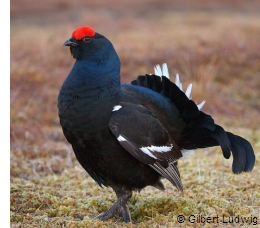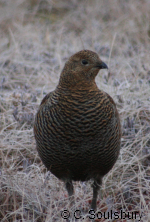Background and Global distribution of black grouse
The black grouse (Tetrao tetrix) is a large bird in the grouse family. Other close relatives include other grouse species (e.g. willow ptarmigan) and pheasants. It is a sedentary species, with a continuous distribution across northern Eurasia from Scandianvia to Siberia. More western and southern populations tend to be fragmented Black grouse have one of the broadest habitat requirements of all the grouse species. A typical species of boreal regions, black grouse inhabit forest edges and areas in the early stages of forest succession. Though found in the forest, grouse prefer not to use areas of closed canopy.
Outside the boreal forest, black grouse are found in structurally similar habitats such as moorland, heaths and bogs, treeline habitats and alpine pastures in mountainous areas, as well as fields and meadows.

Description of black grouse
 Black grouse are large birds with males weighing between 1000-1600 grams. The male almost completely black, apart from red eye combs, white wingbars and under-tail fan. Feathers on the wings can be brownish in colouration, especially in yearling males. The tail is lyre-shaped, which gives a distinctive forked appearance in flight in flight. Though predominantly black, the feathers have a structural colouration which gives them a blueish sheen, especially on the chest and neck.
Black grouse are large birds with males weighing between 1000-1600 grams. The male almost completely black, apart from red eye combs, white wingbars and under-tail fan. Feathers on the wings can be brownish in colouration, especially in yearling males. The tail is lyre-shaped, which gives a distinctive forked appearance in flight in flight. Though predominantly black, the feathers have a structural colouration which gives them a blueish sheen, especially on the chest and neck.
 Black grouse sexually dimorphic and females weigh considerably less than males (750-1110 grams). In contrast to males, females are much duller in colouration, but the colours and patterns can be very variable. In general, they are greyish brown, but can be almost orangey. Females too have a small eye comb.
Black grouse sexually dimorphic and females weigh considerably less than males (750-1110 grams). In contrast to males, females are much duller in colouration, but the colours and patterns can be very variable. In general, they are greyish brown, but can be almost orangey. Females too have a small eye comb.


